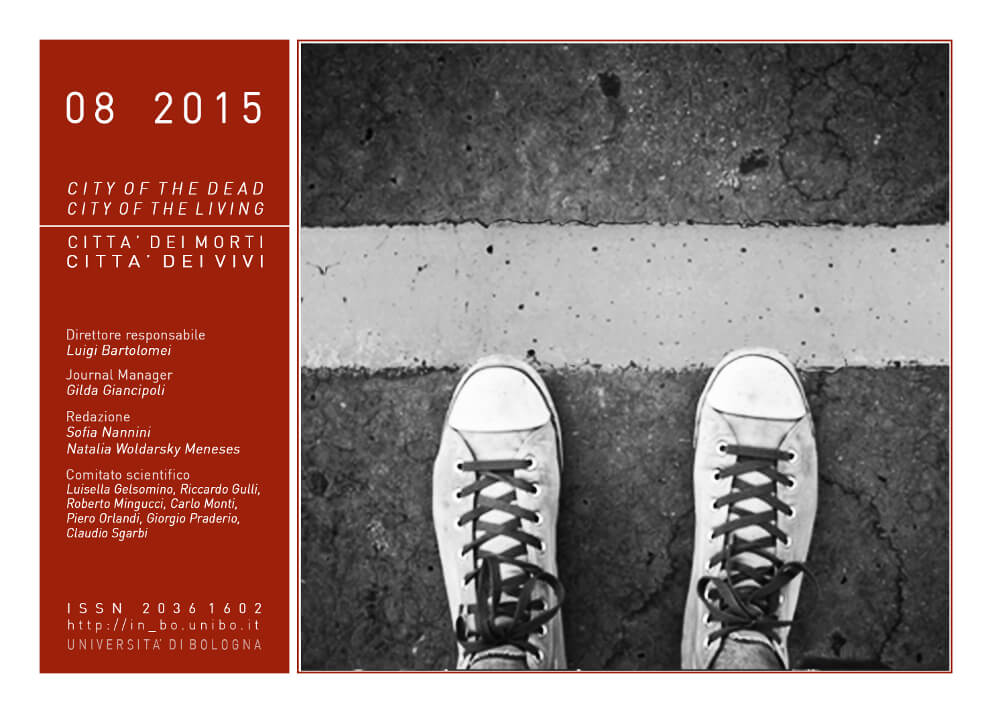Grabeskirche – La chiesa dei sepolcri: un nuovo modello per “cimiteri di quartiere”?
DOI:
https://doi.org/10.6092/issn.2036-1602/6147Parole chiave:
Grabeskirche, Urna, Cimitero, Germania, QuartiereAbstract
Con il calo del sacerdozio e l’aumento della laicità nella maggior parte d’Europa, sono sempre di più le chiese che vengono sottoutilizzate e/o chiuse. Questo articolo indaga come le chiese sottoutilizzate nella Rhein-Westfalia, regione settentrionale della Germania, si siano trasformate in Grabeskirche, dando agli spazi una nuova vita e un ritorno economico alle loro parrocchie. Osservando da vicino la conversione delle cinque chiese in Grabeskirche: St. Joseph ad Aquisgrana, St. Bartholomaus a Colonia, Namen-Jesu-Kirche a Bonn, St. Elizabeth nella periferia di Mönchegadblach e St. Josef vicino a Monchengladbach, i casi studio rivelano come la separazione dei riti cimiteriali, funzioni e rituali può unirsi nuovamente nello spazio liturgico della chiesa. La Grabeskirke rappresenta un nuovo modello economico e culturale che permette ad una chiesa di essere autosufficiente e di rendere possibile il suo mantenimento in un’epoca di post-laicizzazione.Riferimenti bibliografici
Franco Cardini, Gerusalemme, una storia, Il Mulino, 2012, p. 76
J. Ries, Il senso del Sacro nelle culture e nelle religioni, Jaca Book, Milano 2006, p. 132
Alain Guerreau, “Stabilità, via, visione: le creature e il Creatore nello spazio medievale”, in AA. VV, Del vedere: pubblici, forme e funzioni, Einaudi, Torino 2004, p. 169
Philippe Ariès, Western Attitudes toward Death: From the Middle Ages to the Present, John Hopkins University Press, Baltimore 1975, p.10
Bruce Mazlish, Western attitudes toward death: from the Middle ages to the present, in “Journal of Interdisciplinary History”, MIT Press, v. 5, 1975, pp. 751-752
Clément Olivier, Anacronache. Morte e resurrezione, Jaca Book, Milano 1992, p. 66
Victor Stoichita, Breve storia dell’ombra. Dalle origini della pittura alla pop art, Il Saggiatore, Parma 2008, p. 198
Childs Brevard S, Il libro dell’Esodo. Commentario critico-teologico, Pierre, Casale Monferrato 1995, p. 63;
Jacob Benno, Das Buch Exodus, Stuttgart 1997, p. 42
J. C. Smith, Sensous, Worship: Jesuits and the Art of the Early Catholic Reformation in Germany, Princeton University Press, Princeton 2002, p. 133
G. P. Broden, B. D. Andrews, Architecture Principia. Architectural principles of material form, Pearson Education, 2013
Tonino Griffero, Atmosferologia. Estetica degli spazi emozionali, Laterza, Roma 2010, p. 92
Derrida Jacques, Adesso l’architettura, Libri Scheiwiller, Milano 2008, p. 86
Kerstin Gothe, Wolfgang Pehnt, Bernhard Schäfers, Vom Sakralen zum Banalen? Heilige Räume im Wandel, Evangelischen Akademie Baden, Karlsruhe 2011
Peter Borden Gail, Andrews Brian Delford, Ibidem, pp. 4-59
Alberth Gherards, Raum und Geschehen. Vom Zusammenhang zwischen Architektur und Liturgie, Bonn 2013, p. 4
Ronen Bar-El, Teresa García-Muñoz,S. Neuman, Yossef Tobol, The evolution of secularization: cultural transmission, religion and fertility—theory, simulations and evidence, in “Journal of Population Economics”, v. 26, 2013, n. 3, pp. 1129-1174
Downloads
Pubblicato
Come citare
Fascicolo
Sezione
Licenza
Copyright (c) 2016 Chiara Tiloca, Andrea Zangari
I diritti d'autore e di pubblicazione di tutti i testi pubblicati dalla rivista appartengono ai rispettivi autori senza alcuna restrizione.
Questa rivista è distribuita con licenza Creative Commons Attribuzione - Non commerciale 4.0 Internazionale (licenza completa).
Vedere anche la nostra Open Access Policy.
Metadati
Tutti i metadati dei materiali pubblicati sono rilasciati in pubblico dominio e possono essere utilizzati da ognuno per qualsiasi scopo. Questi includono i riferimenti bibliografici.
I metadati – riferimenti bibliografici inclusi – possono essere riutilizzati in qualsiasi formato senza ulteriori autorizzazioni, incluso per scopo di lucro. Chiediamo cortesemente agli utenti di includere un collegamento ai metadati originali.






